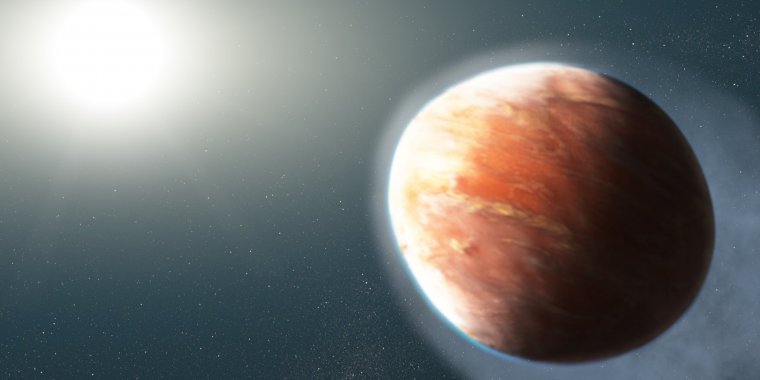| News / Space News |
Hubble Uncovers a ‘Heavy Metal’ Exoplanet Shaped Like a Football
Observations by NASA's Hubble Space Telescope reveal magnesium and iron gas streaming from the strange world outside our solar system known as WASP-121b. The observations represent the first time that so-called "heavy metals"—elements heavier than hydrogen and helium—have been spotted escaping from a hot Jupiter, a large, gaseous exoplanet very close to its star.

This artist's illustration shows an alien world that is losing magnesium and iron gas from its atmosphere. Photo: NASA/ESA/J. Olmsted (STScI)
Normally, hot Jupiter-sized planets are still cool enough inside to condense heavier elements such as magnesium and iron into clouds.
But that's not the case with WASP-121b, which is orbiting so dangerously close to its star that its upper atmosphere reaches a blazing 4,600 degrees Fahrenheit. The temperature in WASP-121b's upper atmosphere is about 10 times greater than that of any known planetary atmosphere. The WASP-121 system resides about 900 light-years from Earth.
Heavy metals have been seen in other hot Jupiters before, but only in the lower atmosphere.
Ultraviolet light from the host star, which is brighter and hotter than the Sun, heats the upper atmosphere and helps lead to its escape.
In addition, the escaping magnesium and iron gas may contribute to the temperature spike. These metals will make the atmosphere more opaque in the ultraviolet, which could be contributing to the heating of the upper atmosphere.
The sizzling planet is so close to its star that it is on the cusp of being ripped apart by the star's gravity. This hugging distance means that the planet is football shaped due to gravitational tidal forces.
The heavy metals are escaping partly because the planet is so big and puffy that its gravity is relatively weak. This is a planet being actively stripped of its atmosphere.
The observations of WASP-121b add to the developing story of how planets lose their primordial atmospheres. When planets form, they gather an atmosphere containing gas from the disk in which the planet and star formed.
These atmospheres consist mostly of the primordial, lighter-weight gases hydrogen and helium, the most plentiful elements in the universe. This atmosphere dissipates as a planet moves closer to its star. (NASA)
YOU MAY ALSO LIKE


